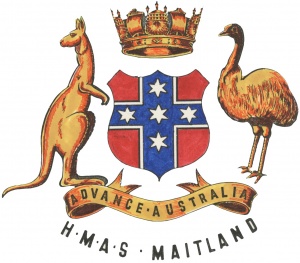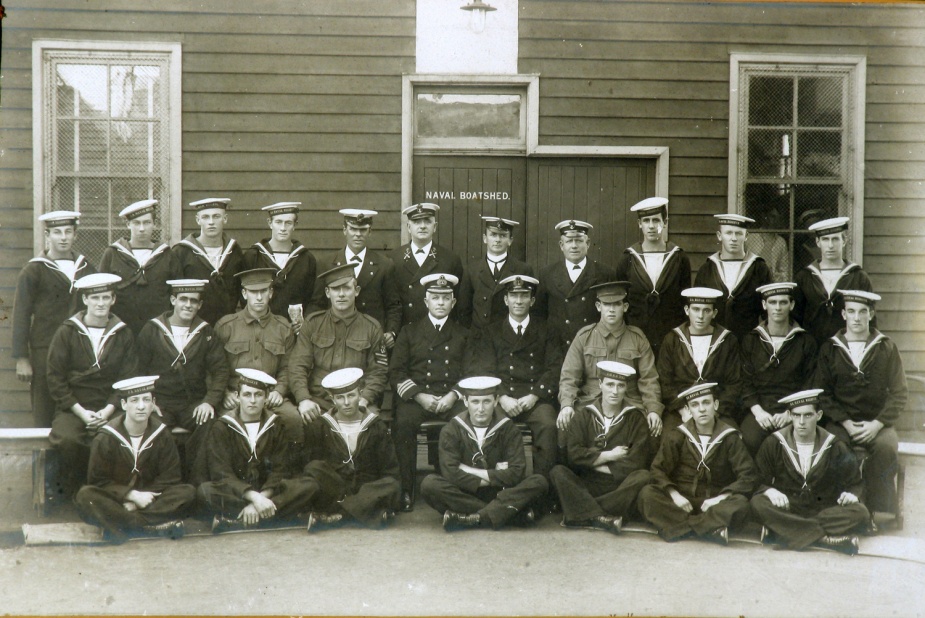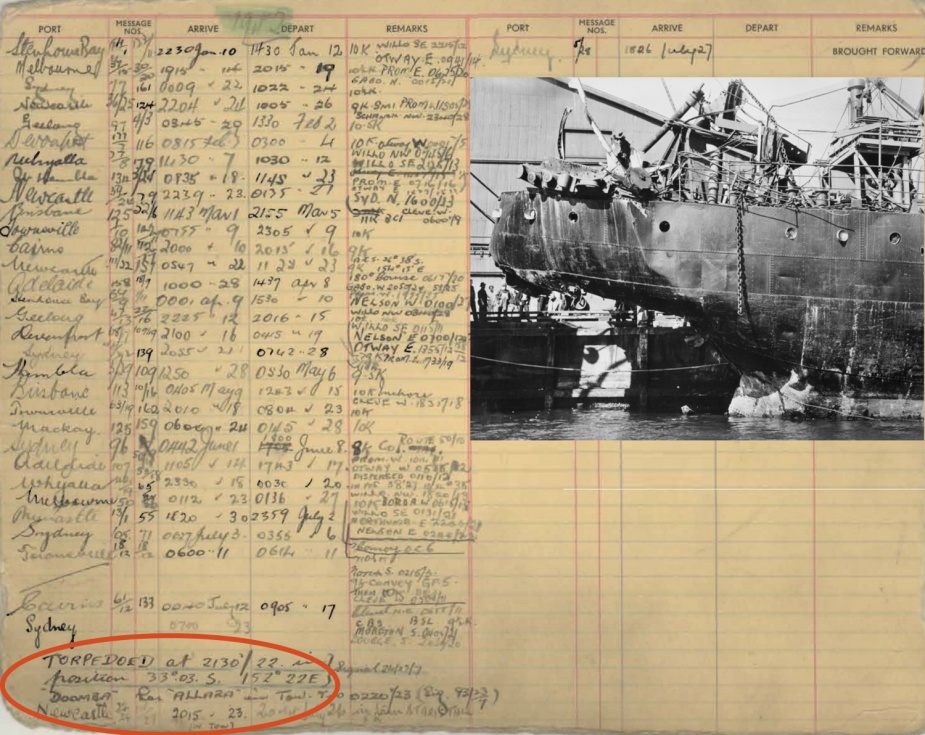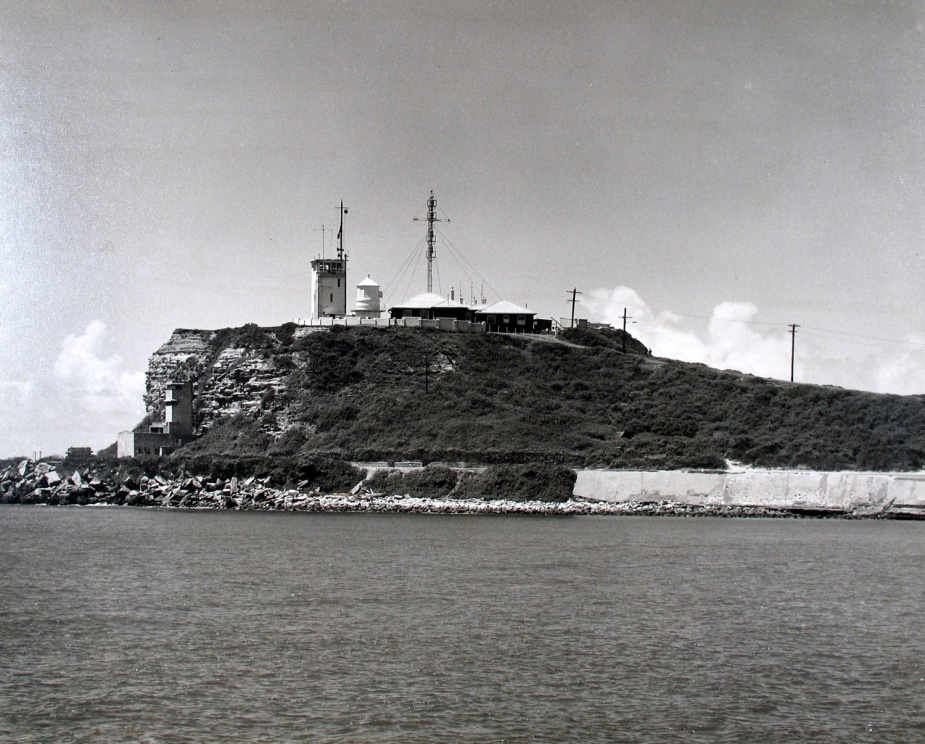HMAS Maitland
HMAS Maitland was a shore-based naval depot in Newcastle, New South Wales.
Newcastle’s naval history dates back to 1863 and colony based Naval Brigades. The Colonial Naval Brigade was a land based force made up of civilians who conducted part-time naval, artillery and militia training. As a reserve force, their role was to provide a surge capability in times of national emergency. Upon Federation, the colonial Naval Brigades came under Commonwealth control, although they continued to be administered at a state level.
In 1907, the State Naval Brigades were consolidated into the Commonwealth Naval Forces. Newcastle was declared a subdistrict of the Commonwealth Naval Forces NSW.[1] Between 1907 and 1911, a naval depot was built between Nobby’s Beach and Horseshoe Beach. The naval depot, which consisted of a boat shed and harbour drill hall, provided for compulsory military training and the operation of a Port War Signal Station (PWSS) and general port security during the First World War.
In the wake of the First World War, Australia’s compulsory military training scheme was abolished in 1929 and all training facilities outside of capital cities were closed. A decade later, however, the world was again facing the prospect of war. Newcastle, with its steel and coal industries and extensive heavy rail system, was identified as a port of strategic significance and a naval presence once again returned to the city.[2]
The Newcastle depot was initially commissioned as HMAS Penguin (III) on 3 September 1939 upon the declaration of war against Germany. This was, however, a short-lived moniker. The existence of multiple Penguins - the result of the naval convention of naming shore establishments ‘Penguin’ followed by a numerical identifier - caused some confusion. It was decided that each establishment would have its own distinct name - preferably reflecting locality - and on 31 July 1940, Penguin (III) was decommissioned. The following day, the Newcastle depot was recommissioned as HMAS Maitland. The Newcastle naval depot could not be commissioned as ‘Newcastle’ as this name was then in service with the Royal Navy. Instead, the base took its name from the small nearby town which was itself named for Sir George Maitland, Under Secretary for the Colonies in the 1830s.[3]
Following the declaration of war, the RAN requisitioned the ground floor of Newcastle Customs House. This was followed by the acquisition of a cottage and land at Nobby’s Beach extending south along the coast to Shepherd’s Hill. In November, work began on the construction of a PWSS at Shepherd’s Hill, to include a concrete watch tower and two huts to accommodate personnel. Work also commenced on seven huts adjacent to the old naval reserve depot, built to accommodate up to 80 officers and sailors. This work was completed in May 1940. By the end of Maitland’s first year of activities, the Commanding Officer, Lieutenant Commander Louis C Rowland, RN, was able to proudly report that “from nothing the establishment has grown to a well organised establishment.”[4]
Activity at Maitland centred on Port Examination Services and Naval Control Services, with responsibility for challenging, boarding and clearing vessels for transit. The PWSS main function was to challenge and identify all approaching vessels - via lamps and signal flags hoisted on the 35 foot flagstaff on Shepherd’s Hill - before they were permitted to enter the harbour. If a vessel could not be identified, it was ordered to stop and held under the guns of Fort Scratchley before being boarded by the Port Examination Services vessel, the pilot vessel SS Birubi. The RAN contingent on board Birubi would then inspect and clear vessels to enter the port. Should a vessel fail to stop, a warning shot was fired from the Fort Scratchely Gun Battery.
Throughout the war, Newcastle’s coast was the site of considerable enemy activity. Two civilian vessels, SS Nimbin and Millimumul, were sunk in December 1940 and March 1941 after they struck German-laid mines. There were also Japanese submarine attacks on the Russian freighter Wellen and SS Allara in May and July 1942. In each of these episodes, ships operating out of Maitland were involved in search and rescue operations, recovering mines, searching for submarines and escorting or towing damaged vessels.
As a port of strategic significance, Group 77 Auxiliary Minesweeper Unit was based at Maitland. Group 77 consisted of seven auxiliary minesweepers employed by Army and Naval Intelligence to search and sweep the New South Wales coast for mines, maintaining a clear channel of 25nm off-shore.
While the attacks on Darwin and Sydney may have cast a longer shadow in Australia’s history of the Second World War, Newcastle also came under attack. In the very early hours of 8 June 1942, as Australia celebrated an Allied victory at the Battle of Midway, the Japanese submarine I-21 fired around 30 shells on Newcastle. Fort Scratchley went into action, marking the first time that an Australian coastal fortification fired heavy guns at a hostile enemy out to sea. The submarine attack resulted in no casualties and superficial damage was caused to the dockyards, steelworks, ocean baths and breakwall.
At around 0900 on 14 June, the PWSS confirmed reports that a submarine periscope had been sighted in the entrance to Newcastle Harbour. The Rail Battery and Wave Battery at Fort Scratchley fired approximately five and sixteen rounds each. At 1340, four Naval Auxiliary Patrol (NAP) vessels deployed “in line abreast”, sweeping the harbour and dropping 30 Mills bombs (hand grenades) to further deter the enemy. The Auxiliary Minesweeper HMAS Bermagui followed along behind in case the submarine’s location became apparent. No hits were made. By 1400 all action had ceased, although the NAP continued to patrol the harbour throughout the remainder of the day and into the evening.[5]
As the threat to the Australian mainland posed by Japan dissipated and the theatre of operations in the Pacific moved further north, Newcastle’s strategic status was reduced and the level of activity there began to peter out. In July 1943, Port Examination Services ceased and Birubi was returned to normal service, and the PWSS was closed in November 1944. By the time hostilities came to a close, Maitland had been reduced to just 14 officers and 35 sailors.[6]
Maitland remained open and operational until 5 September 1946, when the White Ensign was hauled down in the presence of the ship’s company and the Commanding Officer. It was officially decommissioned on 21 September 1946.[7]
- ↑The Oxford Companion to Australian Military History, Second Edition, eds. Peter Dennis, Jeffrey Grey, Ewan Morris and Robin Prior, (Oxford University Press: Sydney, 2008), 464-6.
- ↑Frank Rice and Jacqueline Rice, Not Just a Stone Frigate! HMAS Maitland, Newcastle, New South Wales 1940-46 (F & J Rice, 2006), 3-4; Naval Representation at Newcastle, NSW, 1907-1946, SPC-A 146AG.
- ↑‘The Hunter Fifty Years Ago’, 12 February 1885, The Maitland Mercury (Maitland) p. 7.
- ↑HMAS Maitland War Diary from 28 August 1939 to 31 August 1940, AWM 78/437/1.
- ↑War Diary, Naval Officer in Charge, Newcastle, 22 September 1942, AWM 78/437/1.
- ↑Naval Representation at Newcastle, NSW, 1907-1946, SPC-A 146AG.
- ↑7 September 1946, Newcastle Morning Herald and Miners’ Advocate (Newcastle), p.1









